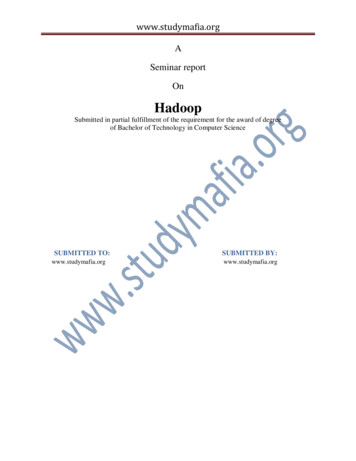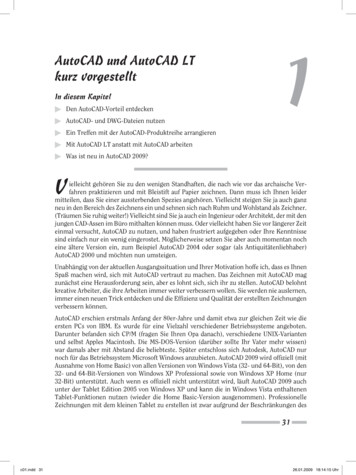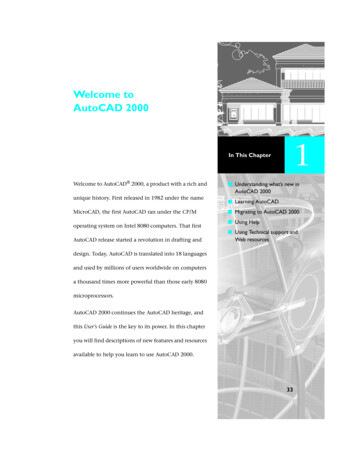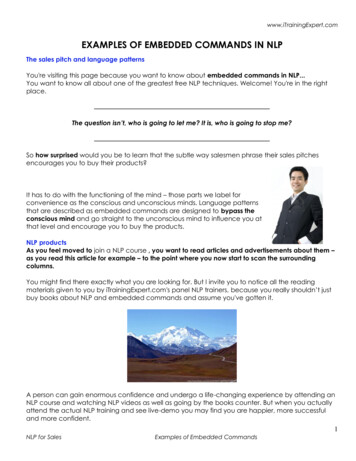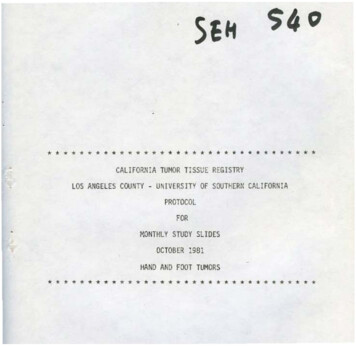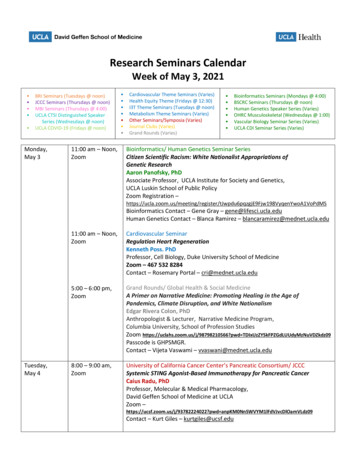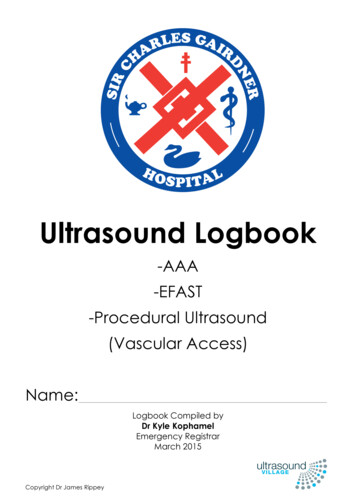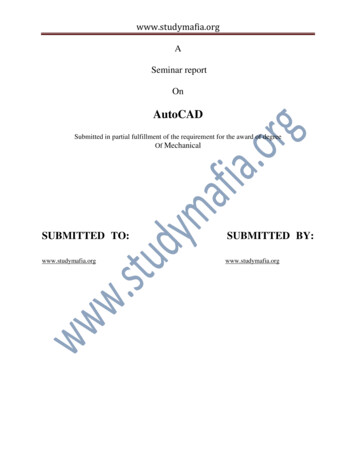
Transcription
www.studymafia.orgASeminar reportOnAutoCADSubmitted in partial fulfillment of the requirement for the award of degreeOf MechanicalSUBMITTED TO:SUBMITTED BY:www.studymafia.orgwww.studymafia.org
www.studymafia.orgPrefaceI have made this report file on the topic AutoCAD; I have tried my best to elucidate all therelevant detail to the topic to be included in the report. While in the beginning I have tried to givea general view about this topic.My efforts and wholehearted co-corporation of each and everyone has ended on a successfulnote. I express my sincere gratitude to .who assisting me throughout the preparation ofthis topic. I thank him for providing me the reinforcement, confidence and most importantly thetrack for the topic whenever I needed it.
www.studymafia.orgAcknowledgementI would like to thank respected Mr . and Mr. .for giving me such a wonderfulopportunity to expand my knowledge for my own branch and giving me guidelines to present aseminar report. It helped me a lot to realize of what we study for.Secondly, I would like to thank my parents who patiently helped me as i went through my workand helped to modify and eliminate some of the irrelevant or un-necessary stuffs.Thirdly, I would like to thank my friends who helped me to make my work more organized andwell-stacked till the end.Next, I would thank Microsoft for developing such a wonderful tool like MS Word. It helpedmy work a lot to remain error-free.Last but clearly not the least, I would thank The Almighty for giving me strength to completemy report on time.
www.studymafia.orgIntroductionAutoCAD is a commercial software application for 2D and 3D computer-aided design (CAD)and drafting — available since 1982 as a desktop application and since 2010 as a mobile weband cloud-based app marketed as AutoCAD 360.Developed and marketed by Autodesk, Inc., AutoCAD was first released in December 1982,running on microcomputers with internal graphics controllers. Prior to the introduction ofAutoCAD, most commercial CAD programs ran on mainframe computers or minicomputers,with each CAD operator (user) working at a separate graphics terminal.AutoCAD is used across a wide range of industries, by architects, project managers, engineers,graphic designers, and other professionals. It is supported by 750 training centers worldwide asof 1994.As Autodesk's flagship product, by March 1986 AutoCAD had become the most ubiquitousCAD program worldwide. As of 2014, AutoCAD is in its twenty-ninth generation, andcollectively with all its variants, continues to be the most widely used CAD program throughoutmost of the world.HistoryAutoCAD was derived from a program begun in 1977 and released in 1979 called Interact CAD,also referred to in early Autodesk documents as MicroCAD, which was written prior toAutodesk's (then Marinchip Software Partners) formation by Autodesk cofounder Mike Riddle.The first version by the AutoDesk Company was demonstrated at the 1982 Comdex and releasedthat December. The 2016 release marked the 30th major release for the AutoCAD for Windows.The 2014 release marked the fourth consecutive year for AutoCAD for Mac.
www.studymafia.orgAutoCAD Architecture featuresGet more in a suiteWalls, doors, and windowsDraw walls, doors, and windows that mimic real-world behavior and construction.Sections and elevationsGenerate 2D sections and elevations directly from your floor plans.Architectural design documentationCreate and annotate drawings with detail components and keynoting tools.
www.studymafia.orgThe AutoCAD AdvantageStriker Systems sheet metal fabrication products are available as a plug-in to AutoCAD or, fornon-AutoCAD users, as a stand-alone solution based on the AutoCAD OEM Engine. Eitherway, this combination provides a unique CAD/CAM environment with features not found inmany conventional manufacturing products.Removal of Data TranslationsStriker Systems provides a truly integrated CAD/CAM solution that supports the entiremanufacturing process from initial part design through the generation of NC programs with nodata translations required. And unlike many manufacturing software products with limiteddesign capability, Striker Systems includes an advanced engineering system for the mostdemanding sheet metal design requirements.SolidWorks / Solid Edge / Inventor CompatibilityThe industry is rapidly embracing 3D solid modeling technology. Being based on Autodesk’sindustry standard DWG file format, Striker Systems offers a level of compatibility not found inother manufacturing solutions. Many products, such as Inventor and SolidWorks, supportStriker’s standard DWG file format directly. And Striker also offers direct OLE links intoSolidWorks, Inventor and Solid Edge for seamless sharing of data.Industry Standard TranslatorsMany Striker Systems clients must accept drawings from a variety of sources. In the event it isnecessary to import data from (or export data to) another CAD software, Striker Systems relieson the same industry standard DXF, IGES, and STEP translators that are found in AutoCAD.Autodesk is the author of the DXF file format and therefore defines this standard. And becauseAutoCAD is the most popular CAD software in the world, it is a benchmark for the developmentof translators by many other CAD software organizations. You are guaranteed the highest levelof compatibility in the industry.Reduced Training Time/CostBoth the AutoCAD based and stand-alone Striker Systems products provide an enhanced userinterface that will be immediately recognizable to individuals familiar with AutoCAD. They willreadily adapt to the Striker environment thereby minimizing the learning curve. And fororganizations that use AutoCAD as their engineering solution, it is not necessary for employeesto learn multiple operating environments as they would with separate CAD and CAM solutions.Rapid Product AdvancementsUnlike the developers of stand-alone manufacturing products, the development team at StrikerSystems is not forced to continually maintain and advance an underlying graphics database. TheStriker graphics database is an AutoCAD engine, the world’s de facto standard CAD solution.
www.studymafia.orgThis allows the Striker Development Team to concentrate on feature development and advancesoftware at a rapid pace.
www.studymafia.orgThe Disadvantages of AutoCADAutodesk AutoCAD is one of the most popular computer-aided design (CAD) programs, and itcreates accurate, professional drawings. However, the program falls short for computer modelingand graphic design. The application has modeling tools, as well as color and fill tools, butAutoCAD does not compare well to contemporary building information modeling (BIM), threedimensional modeling or illustration software.LineoAutoCAD produces drawings using line and shape tools. Curves, arcs and straightlines produce the shapes, but AutoCAD cannot edit the line and location as freelyas illustration programs-- editing and overlapping lines and lineweights is limitedto a few options. In addition, AutoCAD creates drawings from only lines, nevervolumetric models, such as with BIM. Nevertheless, the application can produceprecise three-dimensional geometry with limited material effects.Limited File FormatsoBecause AutoCAD is one of the leading CAD programs, it limits the number offile formats it can import or export, because Autodesk expects other programs toexport to AutoCAD formats, such as DWG and DXF. Unfortunately, this createsproblems when using other programs with more powerful tools and exporting theprogram to an AutoCAD format-- geometry, color and effects are lost often.Color, Fill and TextureoAutoCAD drawings and models can have color, fill and texture, using the line andhatch tools. However, the application limits the number of possible colors to 256and the hatching provides only a handful of textures, so you cannot create photorealistic images like illustration programs. Instead, you can import image files andcreate material maps for AutoCAD renderings, but AutoCAD's rendering abilitiescannot compete with three-dimensional modeling programs or illustrationprograms.Non-ParametricoAutoCAD provides tools to create three-dimensional models, but editing themodels requires many steps, unlike BIM parametric models, which automaticallyadjust all of the model components while editing elements. Furthermore,information is not attached to the models, such as with BIM parametric models-BIM gives the designer data about the material and volumetric properties of thebuilding project.
www.studymafia.orgAutoCAD Entity Types and DescriptionsThere are two formats used by AutoCAD: DXF (drawing exchange format) files, which arelarge; and ASCII representations of the binary DWG (drawing) files. Logically, both files areidentical and, therefore, the FME treats both file types in the same manner. For AutoCAD DWFreading and writing support please see the chapter on AutoCAD DWF.AutoCAD files consist of sections, as follows:1. HEADER: This contains settings of variables associated with the drawing.2. CLASSES: This contains class definitions associated with the drawing.3. TABLES: This contains a variety of tables, including:oLayers: Each layer entry contains layer definition information such as layer color,layer name, and layer linetype. The AutoCAD reader validates the layer namesand may modify them to remove invalid characters.oLinetypes: Each linetype entry contains the linetype definition information suchas name and alignment. The AutoCAD writer enables linetype definitions to becopied from an existing AutoCAD file, then referenced by name during the datatranslation.oShape Files: Each shape file entry identifies a shape file referenced by thedrawing. Shape files are used by AutoCAD as a different method for definingsymbols or fonts. Note: These are similar to the TextStyles in AutoCAD.AutoCAD shape files are not the same thing as Esri Shapefiles. AutoCAD shapefiles store symbol and font definitions.oApplications: Each application entry contains the name of an applicationreferenced within the AutoCAD file.4. BLOCKS: These are used to define symbols and other drawing file objects usedrepeatedly throughout a drawing. The AutoCAD writer enables copying of blockdefinitions from an existing AutoCAD file, which is then referenced by name during adata translation operation.5. ENTITIES: This is the main section of a drawing file and contains the actual featureentities. Each entity contains standard information, such as its color, layer, linestyle, andgeometry, as well as a number of attributes specific to its entity type. For example, all 2Dentities have thickness, while a text entity has fields for font, size, and the text string inaddition to the standard display attributes.
www.studymafia.orgFME supports both 2D and 3D AutoCAD entities. However, many applications onlysupport 2D DWG and DXF files. The 2DForcer transformer can be used to ensure thatonly 2D data is written to an output DWG or DXF file.6. OBJECTS: This section stores dictionaries and other helper non-entity objects.Each entity may also have associated attribution stored within an extended entity data section.FME supports reading and writing of extended entity data.Each entity may also have associated attribution stored within XRecord objects in an extensiondictionary section. FME supports reading and writing XRecord data from entities.All coordinates within a drawing file are stored as 64-bit floating point values in worldcoordinates. As such, there is no need to scale or otherwise alter coordinates as they are beingread from or written to a drawing file.The AutoCAD reader and writer use symbolic names for the different entity types stored within adrawing file. This simplifies feature type specification. The following table gives a briefdescription of each of the different AutoCAD entity types currently supported by the readerand/or writer. The entities are described in detail in subsequent sections.
www.studymafia.orgWhat Is the Difference Between CAD and AutoCAD?Computer-aided design (CAD) is the general term that applies to the use of computers in thedesign of houses, office buildings, interiors and anything else that previously required hands-ondrafting. AutoCAD is a specific piece of software used by many architects and designers forcommercial design purposes. Read on to find out about the uses of CAD and AutoCAD. SchoolsofferingCAD and AutoCAD OverviewAutoCAD is software that utilizes computer-aided design (CAD) principles in the modeling ofbuildings, manufactured goods, urban infrastructure and even fashion design. If you are anarchitect or designer, you might use AutoCAD software to create 2- and 3-dimensional drafts ofcustom home designs or renovations. If you work as a civil engineer, you can use AutoCADsoftware to design improvements in roadways and make cities and towns more energy-efficient.Other industries and professions that employ CAD and make use of AutoCAD software includemanufacturing, automotive technology and engineering.Types of CADDepending on the type of work you perform, there are different forms of CAD that you couldemploy. Drafts that are 2-dimensional are flat, while 3-dimensional and 2.5-dimensionaldrawings show the depth and space of a design. You might use wireframe, surface and solidmodeling to calculate the dimensions of a design or simulate what the inner structure of yourdesign might look like.AutoCAD SoftwareAutoCAD is a trademarked product of Autodesk. When you use AutoCAD, you have the abilityto draft 2-D and 3-D designs and create photorealistic rendering. Because different fields useAutoCAD in specific ways, there are several versions of the AutoCAD application for a varietyof work types, such as architecture, mapping and piping design.Learning AutoCAD SoftwareTechnical schools or community colleges offer stand-alone courses in CAD that you cancomplete in a few weeks. You can also find CAD courses as part of a certificate or degreeprogram, such as a fashion design or architecture program. You can enroll in courses andprograms that specifically teach the AutoCAD application, though some schools might use othersoftware, such as SolidWorks or TurboCAD, instead.
www.studymafia.orgAutodesk also offers courses and training programs through authorized certification centers.These courses can prepare you to earn certification in AutoCAD from the vendor. Depending onyour skill and knowledge level of the application, you can become an AutoCAD Certified User,AutoCAD Certified Associate or AutoCAD Certified Professional. Autodesk certificationdemonstrates your proficiency of the AutoCAD application.To continue researching, browse degree options below for course curriculum, prerequisites andfinancial aid information. Or, learn more about the subject by reading the related articles below:BASIC DRAWING COMMANDS FOR AUTOCADMeasuring CommandsGRID:Displays a grid of dots at a desired spacing on the screen.Command: GRID (enter)On/Off/Tick spacing(x)/Aspect: (enter value) (enter)SNAP:locked intoSpecifies a "round off" interval so that points entered with the mouse can bealignment with the grid spacing.Command: SNAP (enter)On/Off/Value/Aspect/Rotate/Style: (enter value) (enter)Basic Draw CommandsCIRCLE: Draws circles of any size.Command: Circle (enter)3P/2P/TTR/ center point : (pick a center point)Diameter or Radius : (Pick a point on the circle)LINE:Draws straight lines between two pointsCommand: LINE (enter)
www.studymafia.orgFrom Point: (pick a point using the mouse)To Point: (Pick a point using the mouse)To Point: (Press return to end the command)ARC:Draws an arc (any part of a circle or curve) through three known points.Command: ARC (enter)Center/ Start point : (pick the first point on the arc)Center/End/ Second point : CCenter: (pick the arc's center point)Angle/Length of chord/ End point : (pick the arc endpoint)Display CommandsLIMITS: Sets the size of the drawing paper. For size "A" drawing paper the limitsshould be set for10.5 x 8.Command: LIMITS (enter)On/Off/Lower left corner 0.0000 (enter)Upper right corner: 10.5,8 (enter)ZOOM:Enlarges or reduces the display of a drawing.Command: ZOOM ax/Window/ Scale(x/XP) :(pick a point to define one corner of a rectangular viewing window then pick apoint to definethe second point to define the opposite diagonal corner of theviewing window)
www.studymafia.orgNote: To return the picture to its original viewing size enter ALL and press theenter key when prompted instead of defining a window.PAN:Allows you to move your view point around the drawing without changing themagnificationfactor.Command: PAN (enter)
www.studymafia.orgBASIC DRAWING COMMANDS FOR AUTOCADEditing CommandsCHANGE: Alters properties of selected objectsCommand: CHANGE (enter)Select objects or window or Last (select objects to be changed)Properties/ Change point : (type P)Change what property (Color/Elev/LAyer/LType/Thickness)? (type Layer)New Layer: (enter new layer name and press enter)ERASE:Erases entities from the drawing.Command: ERASE (enter)Select objects or Window or Last: (Select objects to be erased and press enterwhen finished)EXTEND: Lengthens a line to end precisely at a boundary edge.Command: Extend (enter)Select boundary edge(s).Select Objects (pick the line which represents the boundary edge which lineswill be extendedto)(press enter when finished selecting cutting edges) Select object to extend /Undo: (pick the line(s) that need to be extendedTRIM:Trims a line to end precisely at a cutting edge.Command: Trim (enter)Select cutting edge(s).
www.studymafia.orgobjects will beSelect Objects (pick the line which represents the cutting edge of line in whichtrimmed to)(press enter when finished selecting cutting edges) Select object to trim /Undo: (pick the line(s) that need to be trimmed)GRIPSYou can edit selected objects by manipulating grips that appear at defining points on theobject. Grips is not a command. To activate grips simply pick the object. Small squareswill appear at various entity-specific positions. By selecting an end grip you can stretch theentity to change its size. By selecting the center grip you can move the entity to a newlocation. To remove grips press CTL-C twice. You can perform the following using grips:Copy, Multiple Copy, Stretch, Move, Rotate, Scale, and Mirror.Creating LayersLAYER:those layers.Creates named drawing layers and assigns color and linetype properties toCommand: LAYER (enter)A Layer & Linetype Properties dialog box will be displayed. To add a newlayer, pick the New button. A new layer listing appears, using a default nameof Layer1. the layer name can be changed by highlighting the layer name.Colors and Linetypes can be assigned to each new layer by picking the colorbox to assign a color and picking the linetype box to assign a line type.Standard AutoCAD colors1 Red2 Yellow3 Green5 Blue6 Magenta7 WhiteStandard AutoCAD linetypesHidden2 hidden lines4 Cyan
www.studymafia.orgCenter2 center linesPhantom2 phantom or cutting-plane lines
www.studymafia.orgBASIC DRAWING COMMANDS FOR AUTOCADConstruction CommandsARRAY:Makes multiple copies of selected objects in a rectangular or circular patternCommand: ARRAY (enter)Select objects or Window or Last: (select object to array)Rectangular or Polar array (R/P) current : (P)Center point of array: (pick the point around which to form the array)Angle to fill ( CCW, - Cw) 360 : (enter)COPY:Draws a copy of selected objects.Command: COPY (enter)Select objects or Window or Last: (select objects to be copied)Base point or displacement: (pick a point on the object to be use as a referencepoint)Second point of displacement: (pick a point which represents the new locationof the copiedobject)MIRROR: Makes mirror images of existing objects.Command: MIRROR (enter)Select objects or Window or Last: (select objects
AutoCAD, most commercial CAD programs ran on mainframe computers or minicomputers, with each CAD operator (user) working at a separate graphics terminal. AutoCAD is used across a wide range of industries, by architects, project managers, engineers, graphic designers, and other professionals. It is suppor
